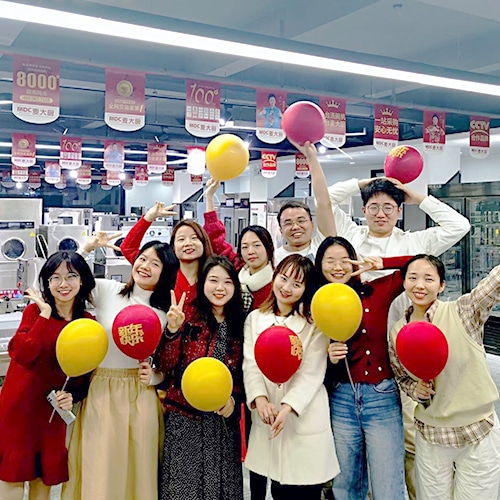What you need to know about creating owning a Asia food restaurant
Asian food is gradually becoming known all over the world for its unique flavor and restaurant culture. Asia as a vast area contains numerous food cultures, so if you are interested in opening an Asian food restaurant, then this article covering Asian food culture, kitchen layout and Asian restaurant kitchen equipment list can effectively help you.
1. How to define a Asia food restaurant?
A. North Asia
The North Asian diet is represented by Russia, where bread, grains and starchy foods are eaten in abundance due to the cold weather. Russians also favor meat, fish and soups, and many like to drink strong alcohol to keep the cold away. Restaurants often use ovens and soup pots to make large roasts, dessert breads and a variety of soups.
B. East Asia
Rice, noodles, tea and soy products are Chinese staples. Dumplings, buns and other dishes with Chinese characteristics are well known around the world. Chinese cuisine varies greatly geographically, but dishes all focus on color, aroma and taste. Stewing, stir-frying, deep-frying, and steaming are common cooking methods, and restaurants use simple woks and steamers as tools.
Traditional Japanese cuisine is based on dishes such as rice and noodles, with an emphasis on seasonal ingredients. Seafood can be eaten raw as sashimi or sushi, and deep-fried tempura is better known. Fryers, rice steamers and griddles are used to prepare the dishes.
Rice and kimchi are the traditional Korean diet and are usually served with grilled meat, fried chicken or noodles. Soju is the most famous traditional Korean spirits. Korean army stew has become one of its popular dishes. Cooking tools such as noodle cookers, fryers, and stew pots are mostly used.
C. South Asia
Chicken and lamb tend to be the most commonly consumed meats in South Asia. A feature of Indian civilization’s cooking is the daily use of curry in meals. In addition to rice, pancakes made from wheat or barley are a major part of the diet, and restaurants can make these delicacies in stirring pans and frying pans.
D. Southeast Asia
Southeast Asian food emphasizes light dishes with strong aromatic elements. The cooking process includes a balanced combination of stir-frying, steaming and boiling, with rice and seafood as staples, and restaurants use gas and noodle stoves to make dishes such as tom yum kong, fried rice noodles and fried rice.
E.West Asia
Dairy products are widely used, especially yogurt and buttermilk, in addition to butter and cream. Hot drinks are preferred, rice, bread is a staple, and lamb is usually made into kebabs or grilled meat. West Asian restaurants use ovens and grills to make bread, pancakes and meats, and use coolers to preserve cheese.
2. How to design a commercial kitchen layout for your Asia restaurant
The difficulty of kitchen design is the acquisition, placement and maintenance of Asian restaurant kitchen equipment, but by following the principles of automation, convenience, standardization, space efficiency and sanitation, you can design your own commercial kitchen to suit your reality. The difficulty in kitchen design is the use of space in your kitchen and the space available in your kitchen.
A.Automation
Only when commercial kitchen equipment is semi-automated or fully automated can kitchen efficiency be maximized. Take potatoes as an example, its cleaning, peeling, cutting strips and cubes can save a lot of time and labor if it is realized by vegetable washing and cutting machines.
B.Convenience
One-stop kitchen equipment should be convenient for employees to operate, the operation process should not be too cumbersome, otherwise not only can not play a role in improving efficiency, but also spend too much time and cost in training employees. Kitchen equipment should be easy to operate, only need simple training staff can easily use.
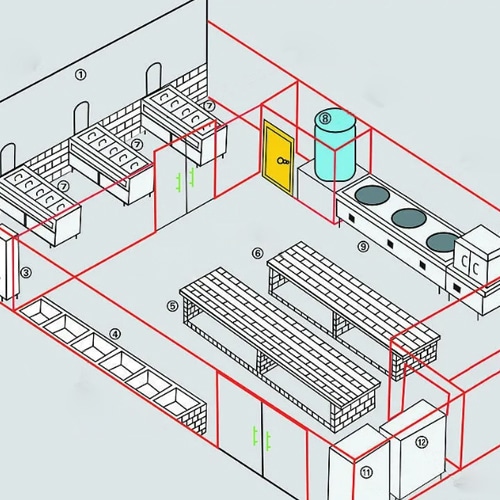
C. Standardization
Commercial kitchen equipment needs to run continuously for many hours a day, once the failure will greatly affect the production, so the quality of the machine is very demanding, you can guarantee the standard machine quality by choosing an experienced supplier.
D.Space efficiency
Choose the necessary equipment according to the menu and space. If your kitchen space is limited, then choose only essential or multifunctional equipment. For example, if you need a meat grinder and a vegetable chopper, then you can acquire a multifunctional chopper.
Modularity: Your menu may need to change depending on the season or the best-selling category, and the kitchen needs to change accordingly. If the Asian restaurant kitchen equipment has wheels for easy mobility or is small enough to be matched and positioned, you can easily move and combine the modules when you need to change.
Logical flow: The primary order of service provided by one-stop kitchen equipment is storage, preparation, cooking and cleaning. Storage and preparation areas should be located away from the door so that they do not interfere with staff delivering meals, and storage and cleaning areas should not be too close to each other to prevent used dishes or cleaning solutions from contaminating stored ingredients.
E. Hygiene
Stainless steel. The surface of the equipment made of stainless steel is smooth and not easy to rust.
Easy to move the equipment. Smaller size or equipment with wheels can be moved easily for cleaning the back and floor.
3. A complete Asia restaurant equipment list
A. Storage equipment
Asian (especially Thai) food emphasizes fresh ingredients, general double-door freezers can basically meet the daily needs of the restaurant, more expensive seafood will also have higher requirements for refrigeration, the specific type and capacity of the freezer needs to be decided according to the menu and daily needs.
Commercial freezer: store a variety of meat, seafood and cheese, pay attention to raw and cooked food separate storage and regular defrosting, planning ingredients placed in the area in order to pick up.
Fresh cabinet: used for short-term storage of cooked food, fresh meat, vegetables and yogurt to extend the shelf life. Horizontal cabinets with glass doors can also be placed in the front room as display cabinets for salads and snacks.
B. Food processing equipment
If you have a restaurant with a large order book and have to handle a lot of ingredients every day, which costs a lot of time and labor, or if you want to standardize the specifications of the ingredients at the primary processing stage, you can purchase some food processing equipment to solve the problem.
Dumpling Machine / Bun Machine: As part of traditional Chinese food, these types of noodle products are so popular that many restaurants will buy factory-made frozen noodles directly. Using a machine to make your own has the advantage that you can introduce special recipes.
Continuous feed food processor: Helps chop cheese, lettuce, onions, bell peppers, radishes, cucumbers, etc. for stuffing, vegetable pieces in curries and salads.
Meat grinder/chopper: quickly process meat for standard stuffing, steaks and lamb chops.
Mixer: used to whip egg whites and cream, stir fillings or dough, suitable for preparing doughs and batters in Asian restaurants with baked goods on the menu.
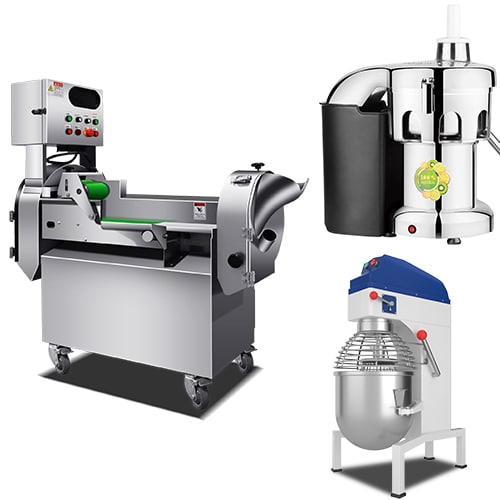
C. Cooking Equipment
Cooking is the core part of the kitchen, and cooking equipment should be chosen according to the categories on the menu. You can choose the necessary items first and then adjust them according to the sales of the meals.
Frying dumpling machine: You can use it to make pan-fried dumplings, pancakes, fried buns and other dishes, which are popular in Asian-style restaurants.
Gas stove/induction cooker: Depending on local regulations and energy prices, you can choose a gas or electric stove, which is versatile and is the most important Asian restaurant kitchen equipment for simmering curries, making soups, stir-frying meats and vegetables, etc.
Commercial rice cooker/steamer: Rice is a staple food in many parts of Asia, and restaurants generally use rice cookers to serve rice. If you have enough space and budget, you can consider a multi-functional steamer with a larger capacity to also steam pasta, meat and seafood, depending on your needs.
Soup Oven: Soups play an important part in both North and East Asian diets, with a sweet and salty difference, with North Asia using mainly vegetables and cream, and East Asia using meat and vegetables.
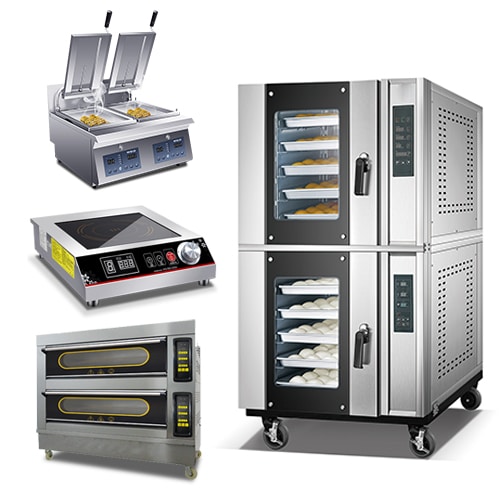
Commercial oven/steam oven: Ovens use hot air circulation and can recharge steam. Multifunctional steam ovens can steam, bake, and mix steam and bake, suitable for making pizzas, pies, breads, desserts, steamed seafood, etc., suitable for North and West Asian style restaurants that love baked goods.
Commercial pasta cooker: indispensable Asian restaurant kitchen equipment for making Tom Yum Goong, clear water vegetarian noodles, ramen, etc.
Commercial grills: used to make fried vegetables, fried noodles, fried rice, steak and other fried food, ornamental, so it can be placed near the front room to attract customers to watch the cooking process.
Commercial fryer: It is suitable for tempura, fried chicken, fried fish, spring rolls, and other fried products, which are usually applied in Japanese and Korean food.
D. Cleaning equipment
In addition to using high quality detergents and frequent cleaning, the following equipment can also help maintain hygiene and safety.
Commercial dishwasher: Wash and dry used dishes. Depending on the traffic and turnover, an uncovered dishwasher can basically meet the cleaning needs of a restaurant, or if your restaurant has a water bar, a smaller under-counter dishwasher can be placed under the table to clean glasses.
Disinfection cabinet: Use high-temperature steam and ultraviolet light to disinfect, reduce the growth of bacteria and ensure the clean use of tableware.
Range hood: Effectively reduces grease and smoke from attaching to equipment, floors and walls, and purifies the air.
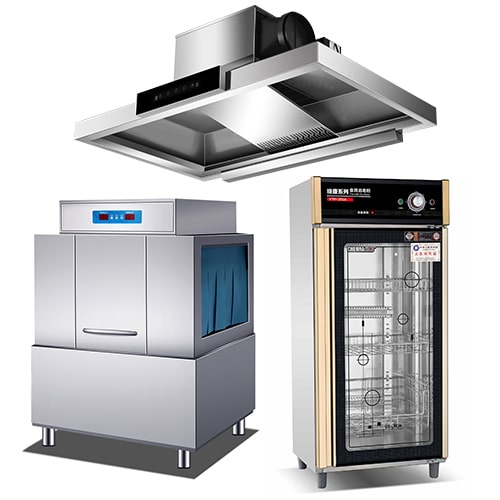
4. Why work with Chefmax
Chefmax is based in Asia and sells its products all over the world. With nearly 20 years of experience in product manufacturing and kitchen design, we have a wide range of products, most of which have undergone strict CE and ETL tests to guarantee excellent performance and safe operation, providing you with the most professional and comprehensive one-stop Asian restaurant kitchen equipment, consultation according to your actual situation, free design drawings, fast production of customized products, real-time video guidance and excellent after-sales service to create your own efficient restaurant. Click [email protected] to get your private one-stop Asia restaurant solutions.
